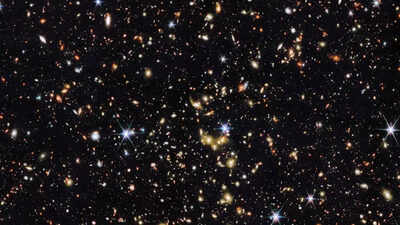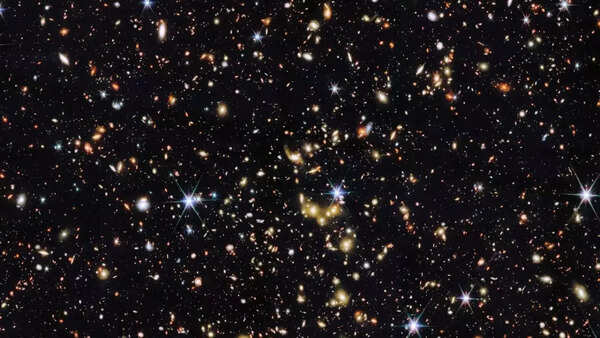NASA's James Webb Telescope captures thousands of galaxies in one picture | - The Times of India

In an awe-inspiring moment for space exploration, NASA's James Webb Space Telescope (JWST) has snapped a breathtaking photo featuring thousands of galaxies in one picture. The incredible landscape is a part of the
COSMOS-Webb survey
. It is one of the biggest surveys ever carried out by the telescope. The picture is a profound and dimensional window into the universe that extends for billions of years. It contains everything from star systems close by to distant galaxies created only a short time after the Big Bang. Every element contributes to how the universe has developed. As a result of Webb's strong infrared capabilities, scientists can now observe structures and galaxies that were out of sight before. This new information is assisting researchers to investigate how galaxies evolve, develop, and engage across the long expanse of cosmic history.
The image showcases a massive field of galaxies located at varying distances, offering astronomers a chance to peer into the past. Since light from distant objects takes billions of years to reach us, looking at far-off galaxies is like looking back in time. Some of the galaxies in this frame existed not long after the Big Bang, providing rare insight into how the universe looked during its earliest stages.
This is an image from the COSMOS-Web project, the Webb mission's largest near-infrared survey. It is led by Dr. Ghassem Gozaliasl of the University of Helsinki and maps 0.54 square degrees of the sky—over twice the size of three full moons. It is designed to investigate
galaxy formation
, star formation, and dark matter structures over billions of light-years. It occupies more than 250 hours of telescope time and returns data that will be kindling for scientific investigation for years to come.
Unlike earlier observatories, JWST employs infrared detectors to see through cosmic dust and capture the faint light of distant galaxies. While Hubble and Chandra have offered visible and X-ray information, Webb sees further—uncovering faint, red-shifted galaxies too far away to be seen previously. These galaxies, many of which are little more than spots in the picture, are some of the universe's earliest to have formed.

One of the more striking aspects of the image is a glittering gold-hued cluster at the center, symbolising a tight packing of galaxies. The clusters play a key role in understanding galaxy evolution. More than half of all galaxies live in groups or clusters, where gravity interacts in a dramatic way—initiating mergers, gas stripping, and occasionally creating new stars.
Within galaxy clusters, the interactions are fierce. Gravity can distort galactic forms, trigger collisions, or even suppress star formation. Ram pressure stripping is a process that strips galaxies traveling through a thick cluster of gas, typically resulting in their aging and evolution. Such dynamic conditions define the destiny of every galaxy and make the cosmic web the elaborate structure it is.
By viewing colors in Webb's image, researchers can make guesses about galaxy age and rates of activity. Younger stars shine with blue light, whereas older stars glow red. Faraway galaxies appear red due to redshift—the cosmic expansion, which stretches light waves. This color coding assists researchers in charting star formation rates and gaining insight into galaxy life cycles.
The Webb Telescope's sensitivity to faint infrared light is already sparking new theories of galaxy evolution. Scientists are particularly interested in galaxies from the reionisation epoch, when the first stars reionised hydrogen gas in the universe. Mapping how star mass is tied to halo mass, scientists hope to reveal secrets about stability, structure, and future star formation.This one picture is more than just a snapshot—it's a rich data set full of history and discovery. The combination of data from Webb, Hubble, Chandra, and more enables astronomers to build detailed timelines of the evolution of the universe. With further analysis, this deep-space image will aid in solving some of astronomy's greatest questions regarding matter, energy, and the destiny of galaxies.











